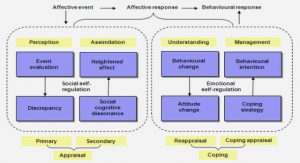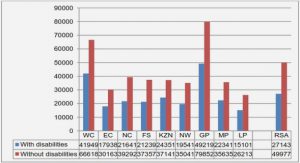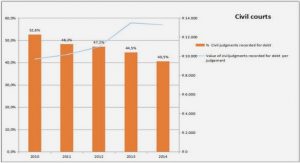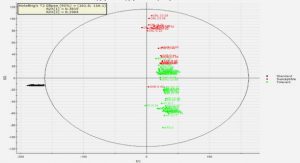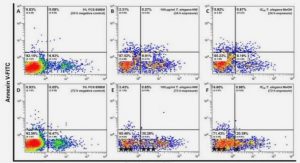Get Complete Project Material File(s) Now! »
PROBLEM STATEMENT
Listeria monocytogenes is a Gram-positive, facultatively anaerobic, psychrotrophic non-spore forming rod that is the aetiological agent of the human disease listeriosis, a rare but highly fatal food-borne infection (Donovan, 2015). The organism survives largely as an environmental saprophyte with major sources being water, soil, and vegetation (Linke et al., 2014). Human infections of L. monocytogenes arise from the ingestion of contaminated foods which in most healthy individuals, are largely without any consequences or at worst can manifest as self-limiting gastroenteritis (Warriner and Namvar, 2009). However, in the major risk groups such as immunocompromised persons, pregnant women, the elderly and infants, L. monocytogenes infections result in a highly invasive form of the disease characterized by septicemia, meningitis, encephalitis, perinatal infections, and abortions (Drevets and Bronze, 2008). While the frequency of occurrence of invasive listeriosis is relatively lower compared to infections caused by other food-borne pathogens such as Salmonella and Campylobacter, the high fatality rate of 20-30% in outbreaks makes it the deadliest of all food-borne infections (Warriner and Namvar, 2009). The main vehicle foods associated with listeriosis outbreaks are contaminated ready-to-eat (RTE) foods, such as processed meats, smoked fish, soft cheeses, and salads (Angelo et al., 2017; Currie et al., 2015; Gillesberg Lassen et al., 2016; Heiman et al., 2016; Stephan et al., 2015). The absence of any thermal processing of these foods prior to consumption means that in the event of any post-processing contamination, control of the pathogen depends largely on the physicochemical characteristics of the foods such as pH, and water activity (aw) (Shabala et al., 2008). In these RTE foods, the risk of listeriosis is related to the ability of the food product to support L. monocytogenes growth during the product shelf-life. Owing to its psychrotrophic nature, the organism can readily multiply to dangerous levels in low- temperature stored RTE foods especially if the physicochemical hurdles are insufficient to prevent its growth (Wemekamp-Kamphuis et al., 2002). Based on Codex Alimentarius Commission (CAC) categorization, RTE foods with a pH > 4.4, aw > 0.92, or a combination of pH > 5.0 and aw > 0.94 are considered capable of supporting L. monocytogenes growth and are therefore high risk (CAC, 2009). Notwithstanding this risk-based profiling, a number of food products historically considered low risk have since been associated with outbreaks in recent years (Centre for Disease Control and Prevention (CDC), 2015a, 2015b, 2015c; Fretz et al., 2010; McCollum et al., 2013). These atypical vehicle foods historically not expected to support L. monocytogenes growth, include whole fruits (e.g. cantaloupe, apple, stone fruit), frozen foods (e.g ice-cream) and acid soft cheeses (CDC, 2015a, 2015c; Fretz et al., 2010). These realizations have raised questions about the current understanding of the ecology of L. monocytogenes growth and survival in foods (Buchanan et al., 2017). Like all pathogens, the success of L. monocytogenes as a pathogen depends on its ability to survive and overcome the many environmental stresses that it encounters along the food chain as well as in the host. In the food processing environments, the pathogen may be faced with stresses ranging from fluctuations in temperature, pH, relative humidity, aw as well as nutrient stress (Dikici and Calicioglu, 2013; Sadeghi-Mehr et al., 2016). Studies have shown that responses to these stresses vary among L. monocytogenes strains, serotypes and even among individual cells within a single population (Aryani et al., 2015a; Aspridou and Koutsoumanis, 2015; Lianou et al., 2006; Shen et al., 2014). Remarkably, these variations in stress responses affect the physiological states of the cells which subsequently influence the behavior and fate of the pathogen in contaminated foods, yet a good understanding of this behavior is central to the development of accurate models for prediction, risk quantification as well as effective control measures. A lot of work has already been done to resolve variations in individual strains, with findings, for instance, showing that nearly all post- process contamination of foods is associated with the so-called persistent strains that colonize and establish permanent residence in food processing facilities (Wang et al., 2015; Wulff et al., 2006). However, the extent to which the physiological states of the cells within populations of the same strain affect L. monocytogenes responses in foods is a subject still to be elucidated. What has been apparent from researches involving single cell analysis techniques such as flow cytometry, cell sorting, and vibrational spectroscopy is that the net effect of the variations in response among individual cells is the formation of survivors in different physiological states (Kennedy et al., 2011; Krämer et al., 2016). These survival states consist of sub-lethally injured cells with a reversible damage to their cell components as well as non-injured stress tolerant cells.
TABLE OF CONTENTS :
- DECLARATION
- ACKNOWLEDGEMENTS
- ABSTRACT
- LIST OF TABLES
- LIST OF FIGURES
- CHAPTER 1: PROBLEM STATEMENT
- CHAPTER 2: LITERATURE REVIEW
- 2.1 Introduction
- 2.2 History and taxonomy of the genus Listeria
- 2.2.1 The species L. monocytogenes: Evolutionary lineages
- 2.2.2 L. monocytogenes serotypes
- 2.3 Ecology of L. monocytogenes
- 2.4 Listeriosis: The transition from environmental saprophyte to intracellular pathogen
- 2.5 L. monocytogenes and RTE foods
- 2.6 Responses to environmental stresses encountered in the food chain
- 2.6.1 General stress response
- 2.6.2 Stress-sensing and signal transduction
- 2.7 Responses to specific food-related stresses
- 2.7.1 Osmotic stress response
- 2.7.2 Acid stress response
- 2.7.3 Heat stress response
- 2.7.4 Cold stress response
- 2.8 Food safety implications of L. monocytogenes stress responses
- 2.8.1 Sub-lethal stress and cell injury
- 2.8.2 Overlap in stress responses and cross-protection in L. monocytogenes
- 2.8.3 Stress tolerance and persistence of L. monocytogenes
- 2.9 Predictive modeling of microbial responses and the impact of food related stresses
- 2.10 Conclusions
- CHAPTER 3: HYPOTHESES AND OBJECTIVES
- 3.1 Hypotheses
- 3.2 Objectives
- CHAPTER
- 4.1 Abstract
- 4.2 Introduction
- 4.3 Materials and methods
- 4.3.1 Bacterial strains
- 4.3.2 Stress treatments and induction of injury
- 4.3.3 Determination of sub-lethal injury by plate counts
- 4.3.4 Preparation of cell suspensions and staining
- 4.3.5 Flow cytometry analysis
- 4.3.6 Sorting of subpopulations
- 4.3.7 Resuscitation of injured cells and growth kinetics
- 4.3.8 Recovery of sorted cells by plate counts
- 4.3.9 Data analysis
- 4.4 Results
- 4.4.1 Stress-induced injury by differential plating
- 4.4.2 Stress-induced injury by flow cytometry and differential staining
- 4.4.3 Re-growth potential of sorted cells on BHI agar
- 4.4.4 Lag phase duration (λ) of resuscitating injured cells
- 4.4.5 Maximum specific growth rate (μmax) of resuscitated cells
- 4.4.6 Recovery of injured cells at 4oC
- 4.4.7 Heat map clustering of cell injury, lag phase duration and growth rate
- 4.5 Discussion
- 4.6 Conclusions
- CHAPTER
- 5.1 Abstract
- 5.2 Introduction
- 5.3 Materials and methods
- 5.3.1 Bacterial strains and stress treatments
- 5.3.2 Cheese preparation and inoculation
- 5.3.3 Enumeration of survivors
- 5.3.4 Survival models
- 5.3.5 Statistical evaluation of models
- 5.3.6 Typing of L. monocytogenes survivors from mixed strain challenge tests
- 5.3.7 Data analysis
- 5.4 Results
- 5.4.1 Statistical evaluation of inactivation models
- 5.4.2 Weibull model fitted inactivation curves
- 5.4.3 Inactivation kinetic parameters
- 5.4.4 Typing of L. monocytogenes survivors from mixed strain challenge tests
- 5.5 Discussion
- 5.6 Conclusions
- CHAPTER
- 6.1 Abstract
- 6.2 Introduction
- 6.3 Materials and methods
- 6.3.1 Bacterial strains and stress treatments
- 6.3.2 FT-IR microspectroscopy analysis
- 6.3.3 Spectral processing and data analysis
- 6.3.4 Scanning Electron Microscopy (SEM)
- 6.4 Results
- 6.4.1 Normalized FT-IR spectra
- 6.4.2 Spectral comparison of treated and control cells
- 6.4.3 SEM morphology of treated cells
- 6.5 Discussion
- 6.6 Conclusions
- CHAPTER
- 7.1 Abstract
- 7.2 Introduction
- 7.3 Materials and methods
- 7.3.1 Bacterial strains
- 7.3.2 Lactic acid solutions and determination of undissociated acid concentration
- 7.3.3 Lactic acid-induced L. monocytogenes persistence
- 7.3.4 Susceptibility of survivor isolates to severe acid stress re-exposure
- 7.3.5 Metabolic activity of survivor cells
- 7.3.6 Effect of nutrients on L. monocytogenes persistence
- 7.3.7 SEM examination of lethal acid stress treated cells
- 7.3.8 Relative expression of stress response genes in persister survivors revived under conditions of mild acid and cold stress
- 7.3.9 Data analysis
- 7.4 Results
- 7.4.1 Acid stress-induced persistence
- 7.4.2 Death kinetics of L. monocytogenes cells treated with lethal concentration of
- lactic acid
- 7.4.3 Susceptibility of persister isolates upon re-exposure to lactic acid
- 7.4.4 Effect of nutrient availability on L. monocytogenes persistence
- 7.4.5 Metabolic activity of persister cells
- 7.4.6 Expression of stress response genes in cells re-grown from persister survivors
-
- 7.4.7 Multivariate analysis of gene expression profiles
- 7.5 Discussion
- 7.6 Conclusions
- CHAPTER 8: GENERAL DISCUSSION
- 8.1 REVIEW OF METHODOLOGY
- 8.1.1 Stress treatments and induction of cell injury
- 8.1.2 Flow cytometry and FACS
- 8.1.3 Resuscitation conditions and kinetic modelling
- 8.1.4 Stress and population dynamics in soft cheese
- 8.1.5 FT-IR spectroscopy
- 8.1.6 Lactic acid-induced persistence
- 8.1.7 Metabolic status of persister survivors
- 8.1.8 Considerations for RT-qPCR in gene expression
- 8.1.9 Growth conditions for the revival of persister survivors and choice of stress
- response genes
- 8.2 RESEARCH FINDINGS
- 8.2.1 Influence of strain heterogeneity and stress variability on cell injury response
- and resuscitation kinetics of injured cells
- 8.2.2 Trade-offs between stress tolerance and growth ability possibly explain the differences in stress susceptibility and growth ability of L. monocytogenes strains
- 8.2.3 Individual strain susceptibility and stress tolerance responses influence
- population dynamics in lactic soft cheese
- 8.2.4 Acid stress results in disruption of protein structure, nucleic acid conformations, and cellular polysaccharides
- 8.2.5 Persister cell formation facilitates L. monocytogenes persistence and survival of lethal acid stress
- 8.2.6 Gene expression profiles of persister survivors upon growth resumption
- CHAPTER 9: CONCLUSIONS AND RECOMMENDATIONS
- CHAPTER 10: REFERENCES

